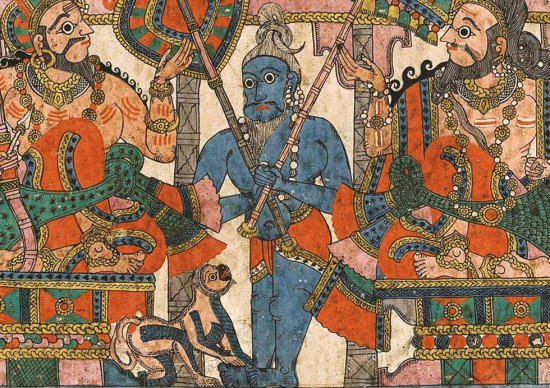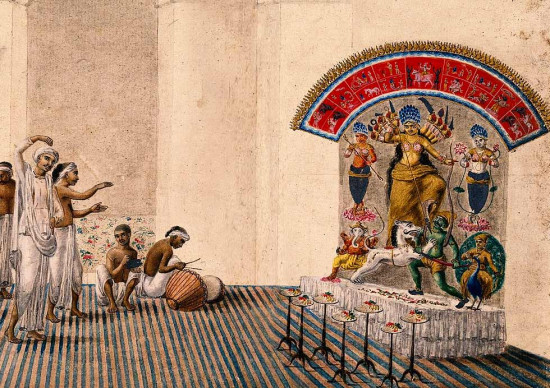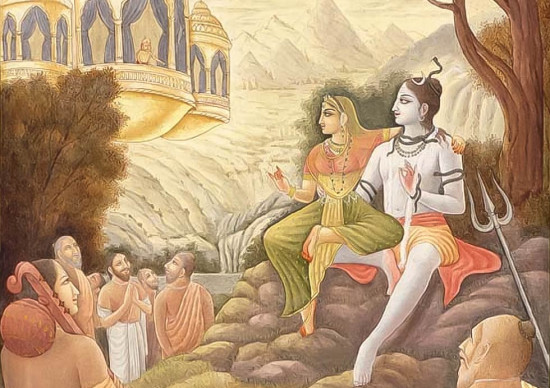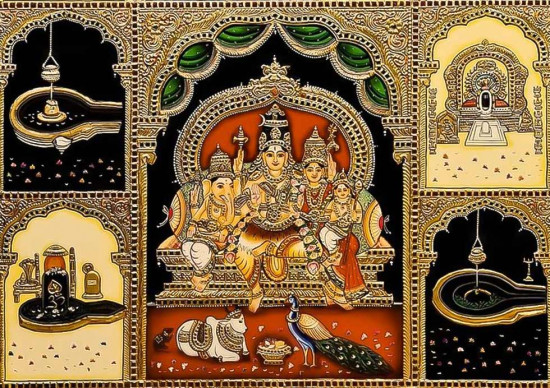
In the aristocratic Kilimanoor neighborhood of the former Travancore state of modern-day Kerala, Raja Ravi Varma was born on April 29, 1848, into a family of high social status.
Around the age of 7, this accomplished painter began to decorate the walls with drawings of animals and scenes from daily life, demonstrating his artistic talent. Nowadays Raja Ravi Varma Painting Prints are very famous in India.
The Puranas and the Itihasas (history), two types of ancient Indian books with rich iconography, were merged with European-style paintings in his well-known distinctive painting style. The outcome was a collection of magnificent paintings that are now priceless and widely wanted.
In Maharashtra, Raja Ravi Varma established a press where oleographs of various themes and scenes from Indian Puranas and Itihasas (history), including the Ramayana and Mahabharata, were printed. These oleographs were extremely well-liked and in high demand.
Thousands of copies of these were printed, and they kept coming even after Raja Ravi Varma passed away. While the press continued to print these oleographs under various regimes, they also hired talented artists to produce new oleograph designs.
Around the age of 7, this accomplished painter began to decorate the walls with drawings of animals and scenes from daily life, demonstrating his artistic talent. Nowadays Raja Ravi Varma Painting Prints are very famous in India.
The Puranas and the Itihasas (history), two types of ancient Indian books with rich iconography, were merged with European-style paintings in his well-known distinctive painting style. The outcome was a collection of magnificent paintings that are now priceless and widely wanted.
In Maharashtra, Raja Ravi Varma established a press where oleographs of various themes and scenes from Indian Puranas and Itihasas (history), including the Ramayana and Mahabharata, were printed. These oleographs were extremely well-liked and in high demand.
Thousands of copies of these were printed, and they kept coming even after Raja Ravi Varma passed away. While the press continued to print these oleographs under various regimes, they also hired talented artists to produce new oleograph designs.
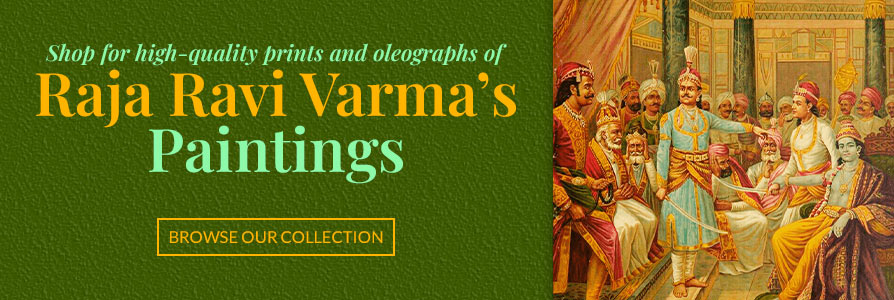
Painting of Hindu Deities by Raja Ravi Varma
The first Indian painter to depict Hindu gods and deities with human features and in natural settings was Raja Ravi Varma. The European realism technique was used by him to depict scenes from Hindu mythology. He was harshly criticized for undermining religious principles. But people continue to enjoy his works and use them to depict current events.
Krishna – Ravi Varma Art Print is one of the famous paintings of the Hindu God Krishna. The piece represents a scene from the Mahabharata in which Krishna makes a last attempt to prevent war by visiting the Kauravas as a peace messenger on behalf of the Pandavas prior to the conflict. Duryodhana not only stops his efforts but also suggests that they be arrested.
As Satyaki is being prevented from fighting Duryodhana, who is giving his man orders to kidnap Krishna, Krishna is portrayed sitting with a casual smile on his face. The assembly’s elders, who disapprove of Duryodhana’s stubbornness, are horrified by his attempt to seize Krishna, the supreme lord.
Rama – Ravi Varma Art Print is another famous print. The scene in which Rama asks for permission to sail across the sea with his army to Lanka is depicted in this painting. He fasts and meditates intensely for three days on the sand. Rama is upset when Ocean doesn’t respond.
Lord Rama decides to get his bow out to dry up all of the ocean’s water with his fire weapon. When the ocean appears with his wives, Rama’s anger is quickly calmed. Observe Rama’s once-strong frame, which has grown frail from fasting, and the pure rage in his eyes. Varuna’s (the god of the ocean) facial expressions and hand motions perfectly portray his desire to please Rama.
Brief About Raja Ravi Varma
The first Indian painter to depict Hindu gods and deities with human features. Raja Ravi Varma was severely blamed for damaging religious principles. His oleographs of various themes and scenes from the Indian Puranas and Itihasas, including the Ramayana and Mahabharata, are very famous.
There are many famous paintings by Raja Ravi Varma of Lord Krishna from Mahabharta and Lord Rama from Ramayana. Raja Ravi Varma’s art was used to print in calendars and in advertising prints. Later he also opened his own press, and there he continued his work.
He was the first artist to make his creations available to everyone, regardless of social status. Raja Ravi Varma’s life was also shown in movies and documentaries. In his honor, there is an award known as The Raja Ravi Varma Puraskaram, and it is given to the people who are doing great in the art field in Kerala.
The first Indian painter to depict Hindu gods and deities with human features and in natural settings was Raja Ravi Varma. The European realism technique was used by him to depict scenes from Hindu mythology. He was harshly criticized for undermining religious principles. But people continue to enjoy his works and use them to depict current events.
Krishna – Ravi Varma Art Print is one of the famous paintings of the Hindu God Krishna. The piece represents a scene from the Mahabharata in which Krishna makes a last attempt to prevent war by visiting the Kauravas as a peace messenger on behalf of the Pandavas prior to the conflict. Duryodhana not only stops his efforts but also suggests that they be arrested.
As Satyaki is being prevented from fighting Duryodhana, who is giving his man orders to kidnap Krishna, Krishna is portrayed sitting with a casual smile on his face. The assembly’s elders, who disapprove of Duryodhana’s stubbornness, are horrified by his attempt to seize Krishna, the supreme lord.
Rama – Ravi Varma Art Print is another famous print. The scene in which Rama asks for permission to sail across the sea with his army to Lanka is depicted in this painting. He fasts and meditates intensely for three days on the sand. Rama is upset when Ocean doesn’t respond.
Lord Rama decides to get his bow out to dry up all of the ocean’s water with his fire weapon. When the ocean appears with his wives, Rama’s anger is quickly calmed. Observe Rama’s once-strong frame, which has grown frail from fasting, and the pure rage in his eyes. Varuna’s (the god of the ocean) facial expressions and hand motions perfectly portray his desire to please Rama.
Brief About Raja Ravi Varma
The first Indian painter to depict Hindu gods and deities with human features. Raja Ravi Varma was severely blamed for damaging religious principles. His oleographs of various themes and scenes from the Indian Puranas and Itihasas, including the Ramayana and Mahabharata, are very famous.
There are many famous paintings by Raja Ravi Varma of Lord Krishna from Mahabharta and Lord Rama from Ramayana. Raja Ravi Varma’s art was used to print in calendars and in advertising prints. Later he also opened his own press, and there he continued his work.
He was the first artist to make his creations available to everyone, regardless of social status. Raja Ravi Varma’s life was also shown in movies and documentaries. In his honor, there is an award known as The Raja Ravi Varma Puraskaram, and it is given to the people who are doing great in the art field in Kerala.

